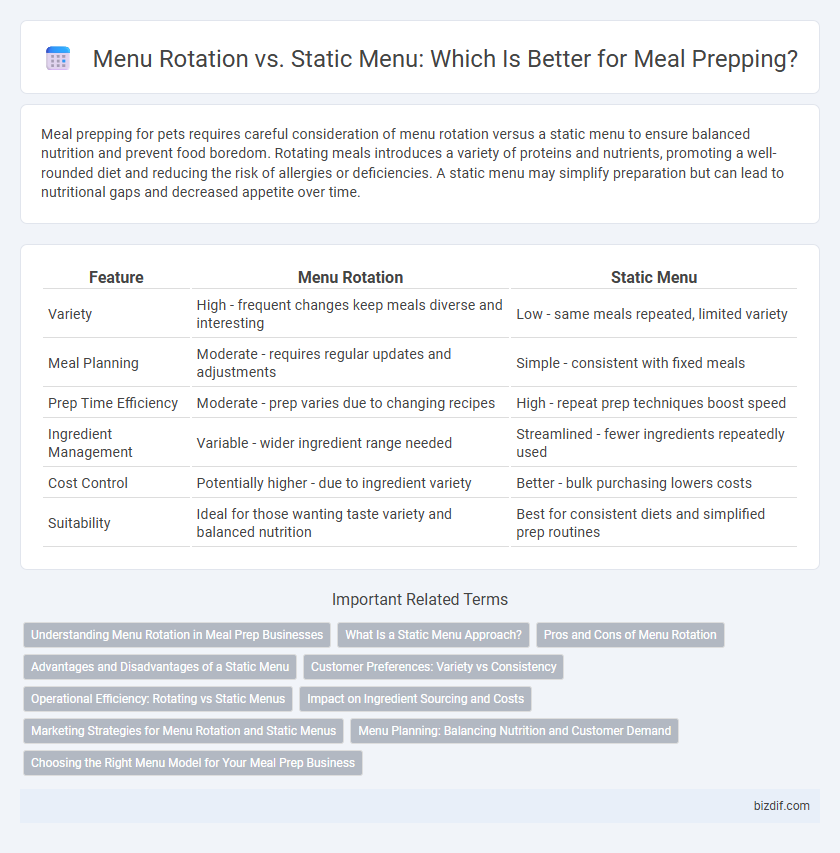Meal prepping for pets requires careful consideration of menu rotation versus a static menu to ensure balanced nutrition and prevent food boredom. Rotating meals introduces a variety of proteins and nutrients, promoting a well-rounded diet and reducing the risk of allergies or deficiencies. A static menu may simplify preparation but can lead to nutritional gaps and decreased appetite over time.
Table of Comparison
| Feature | Menu Rotation | Static Menu |
|---|---|---|
| Variety | High - frequent changes keep meals diverse and interesting | Low - same meals repeated, limited variety |
| Meal Planning | Moderate - requires regular updates and adjustments | Simple - consistent with fixed meals |
| Prep Time Efficiency | Moderate - prep varies due to changing recipes | High - repeat prep techniques boost speed |
| Ingredient Management | Variable - wider ingredient range needed | Streamlined - fewer ingredients repeatedly used |
| Cost Control | Potentially higher - due to ingredient variety | Better - bulk purchasing lowers costs |
| Suitability | Ideal for those wanting taste variety and balanced nutrition | Best for consistent diets and simplified prep routines |
Understanding Menu Rotation in Meal Prep Businesses
Menu rotation in meal prep businesses enhances customer satisfaction by offering varied dishes over regular intervals, preventing menu fatigue. It allows operators to optimize ingredient use, reduce waste, and respond to seasonal availability while maintaining operational efficiency. Unlike static menus, rotating options support dietary trends and cater to diverse preferences, fostering repeat business and streamlined inventory management.
What Is a Static Menu Approach?
A static menu approach in meal prepping involves serving the same set of meals consistently without frequent changes, making it easier to plan, shop, and prepare in bulk. This approach streamlines ingredient usage and reduces decision fatigue since the meals remain constant over time. However, it may result in limited variety and decreased excitement for those seeking diverse flavors or nutritional profiles.
Pros and Cons of Menu Rotation
Menu rotation in meal prepping enhances nutritional variety and reduces meal fatigue by cycling different recipes weekly or monthly, promoting balanced nutrient intake and sustained interest. It requires more planning and grocery coordination compared to static menus, which can lead to increased prep time and potential food waste if not managed carefully. Rotating menus allow for flexibility and seasonal adjustments, whereas static menus offer simplicity and consistency but risk monotony and limited nutrient diversity.
Advantages and Disadvantages of a Static Menu
A static menu offers consistent meal options, simplifying purchasing and preparation processes, which is ideal for establishments seeking efficiency and predictability. However, it may lead to customer fatigue and decreased repeat business due to limited variety, reducing overall satisfaction. Limited flexibility can also hinder adaptation to seasonal ingredients, affecting freshness and potential cost savings.
Customer Preferences: Variety vs Consistency
Menu rotation enhances customer satisfaction by offering diverse meal options that cater to varying tastes and dietary needs, preventing palate fatigue. Static menus appeal to customers who prioritize consistency and familiarity, ensuring reliable meal choices every time. Balancing variety with consistency helps meal prep services tailor offerings to evolving customer preferences while maintaining core favorites.
Operational Efficiency: Rotating vs Static Menus
Menu rotation enhances operational efficiency by reducing ingredient waste and streamlining inventory management compared to static menus, which often lead to excess stock and limited ingredient use. Rotating menus allow kitchens to adapt to seasonal availability and customer preferences, improving food quality and reducing overhead costs. Consistent menu changes also foster staff engagement and reduce menu fatigue, contributing to smoother kitchen operations and faster meal prep times.
Impact on Ingredient Sourcing and Costs
Menu rotation in meal prepping allows for diversified ingredient sourcing, reducing the risk of supply shortages and enabling bulk purchasing of seasonal produce, which lowers overall costs. A static menu, while simplifying procurement by relying on consistent ingredient orders, can increase vulnerability to price fluctuations and limit opportunities to capitalize on market discounts. Strategic menu rotation thus optimizes ingredient availability and cost-efficiency in meal preparation.
Marketing Strategies for Menu Rotation and Static Menus
Menu rotation enhances customer engagement by regularly introducing new flavors, increasing repeat visits and boosting social media buzz through dynamic marketing campaigns. Static menus enable brand consistency and simplify inventory management, making them cost-effective and easier to promote through familiar, trusted branding messages. Effective marketing strategies leverage menu rotation for seasonal promotions, while static menus emphasize signature dishes and brand identity to maintain customer loyalty.
Menu Planning: Balancing Nutrition and Customer Demand
Menu rotation enhances meal prepping by introducing varied nutrients and flavors, reducing ingredient fatigue and improving customer satisfaction. Static menus offer consistency and streamlined inventory management but risk monotony and potential nutritional gaps. Effective menu planning balances diverse nutritional profiles with customer preferences, optimizing both health benefits and demand fulfillment.
Choosing the Right Menu Model for Your Meal Prep Business
Menu rotation enhances customer satisfaction by offering diverse meal options that cater to varying dietary preferences, reducing menu fatigue and increasing repeat purchases. A static menu simplifies inventory management and streamlines kitchen operations, ideal for businesses with limited resources or consistent client demand. Evaluating factors such as target audience, ingredient availability, and operational capacity helps determine the optimal menu model for scalability and customer retention in meal prep services.
Menu rotation vs static menu Infographic

 bizdif.com
bizdif.com